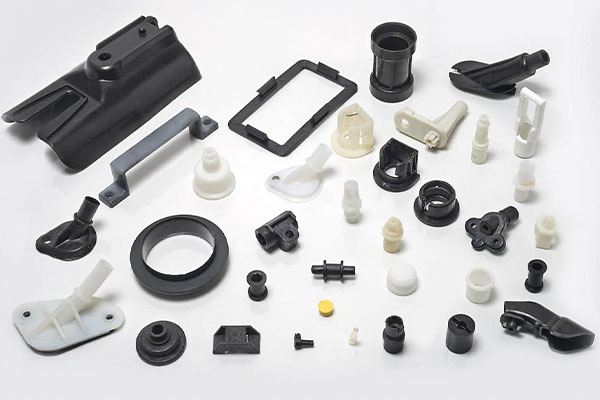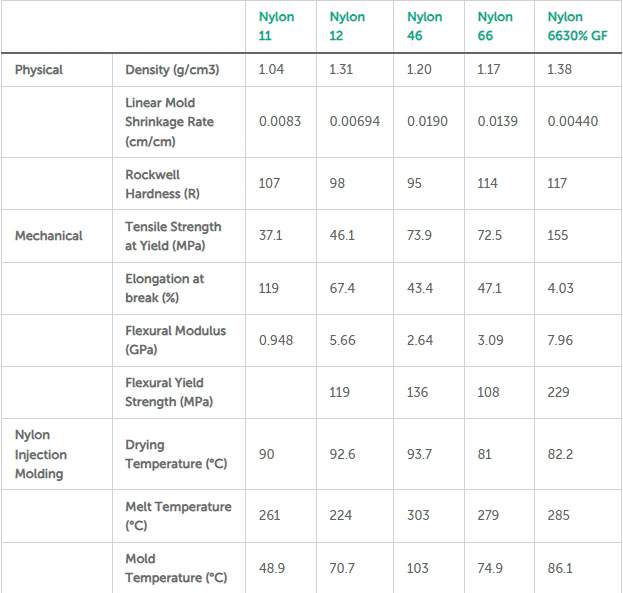Nylon Injection Molding: How to Create the Best PA Parts
A popular thermoplastic for injection molding, nylon is an engineering thermoplastic and a polyamide (PA). It has high crystallinity, a crucial quality that enhances the mechanical strength and thermal performance of plastics. Because of its material qualities, nylon injection molding can be used in place of metal in a variety of applications, including pump parts, fan blades, cable ties, screws, and gears.
Although nylon is available in a wide variety of forms, the most used varieties are Nylon 6, Nylon 66, and PA 12. Although it reduces flexibility, adding fillers like glass fibers can improve the mechanical and thermal qualities of nylon. It’s crucial to keep in mind that nylon absorbs moisture easily and needs to be dried before nylon injection molding can take place when choosing a material. In situations when there is a lot of humidity, nylon may expand during end-use applications.
Notwithstanding these disadvantages, nylon injection molding offers a lot of benefits. These benefits are discussed in this article along with design recommendations for nylon injection molding and an analysis of the material’s characteristics and processing variables. Learn more by continuing to read.

Benefits of Nylon Injection Molding
Nylon is a frequently chosen material for injection molding due to its advantageous physical properties, mechanical characteristics, and suitability for the molding process. These benefits encompass:
Low Melt Viscosity
Nylon exhibits a low melt viscosity, enhancing its suitability for molding parts with thin side walls or delicate features. During the injection process, molten nylon effortlessly navigates through narrow spaces.
Chemical and Abrasive Resistance
Nylon demonstrates resilience against various substances, including dilute acids, inorganic chemicals like ammonia, alkaline solutions, and organic solvents such as halogenated hydrocarbons. Moreover, it displays exceptional resistance to fuels and oils while also boasting excellent abrasion resistance, thanks in part to its low coefficient of friction.
High-Temperature Resistance
Nylon offers a higher maximum operating temperature compared to many other engineering plastics. Although the nylon injection molding demands increased energy input, resulting parts can endure long-term exposure to temperatures as high as 150°C. Glass-reinforced nylon elevates the melting point further, enhancing its resistance to elevated temperatures.
Fatigue Resistance
The outstanding fatigue resistance of nylon renders it an excellent choice for components subjected to cyclic loading, such as gears. Incorporating appropriate corner radii in the design of injection-molded nylon parts can further enhance fatigue resistance.
Tensile and Mechanical Strength
Nylon’s tensile strength rivals that of certain metals, even though it is not as rigid. The mechanical strength of nylon can be further bolstered by adding fillers like glass fibers or by adjusting the mold temperature to optimize the material’s crystalline structure.
Guidelines for Nylon Injection Molding Design
To achieve the desired injection-molded parts, it is essential to adhere to general molding guidelines outlined in our design guide. Additionally, there are four specific considerations for nylon injection molding designs:
Wall Thickness
When designing parts for nylon injection molding, aim for a wall thickness ranging from 0.030 to 0.115 inches (0.76 to 2.92 mm). Notably, this falls slightly below the recommended wall thickness for most other injection molding materials.
It’s crucial to maintain uniform wall thickness, and if this isn’t feasible, implement gradual changes in thickness between adjacent walls, ideally not exceeding a 10% to 15% variation. Wall thicknesses exceeding 6 mm are discouraged.
Nylon’s low melt viscosity allows for lightweight parts with relatively thin walls while ensuring moldability.
Radii
Nylon is sensitive to stress concentrations induced by sharp corners. Therefore, it’s imperative to design parts with corner radii exceeding 0.5 mm. The best part performance is achieved when radii are approximately 75% of the nominal wall thickness.
Draft Angle
Nylon parts can be molded without draft angles due to nylon’s low coefficient of friction, which facilitates easy part ejection. This feature is advantageous for components like gears and those requiring flat surfaces.
However, applying a draft angle to nylon parts can expedite cycle times. Typically, draft angles ranging between 0.5° and 1° per side are employed.
Part Tolerances
Nylon exhibits a higher shrinkage rate compared to most thermoplastics, making it challenging to maintain dimensional tolerances. Nonetheless, when shrinkage rates are effectively controlled, injection-molded nylon consistently meets part tolerances.
This characteristic makes nylon a favored choice for precision components such as gears and bearings.
By adhering to these design guidelines, you can optimize the nylon injection molding process for nylon-based parts, ensuring the production of high-quality and precisely manufactured components.
Nylon Material Properties
The physical, mechanical, and molding qualities of different grades of nylon are listed in the table below. This data demonstrates the exceptional tensile and flexural strength of nylon. Additionally, because nylon is hygroscopic by nature, it needs to be completely dry before nylon injection molding.

Nylon Material Processing
The successful plastic injection molding of nylon relies on careful consideration of several key processing parameters. Here are some of the most critical factors to keep in mind:
Viscosity
Nylon exhibits low melt viscosity, enabling rapid flow through narrow channels before solidifying. This makes it an excellent choice for injection-molded parts with thin walls and long injection paths. Moreover, nylon’s low melt viscosity can significantly reduce cycle times, as it fills mold cavities more quickly than many other plastics.
Moisture
Nylon has a propensity to absorb moisture when not stored correctly. Excessive moisture in injection-molded parts can lead to voids and surface defects. The rate of moisture absorption depends on factors such as the specific nylon grade and relative humidity. Maintaining an optimal moisture content between 0.15% and 0.20% is essential, and higher humidity levels result in quicker water absorption.
Temperature Control
Effective temperature control is crucial in nylon injection molding. Higher mold temperatures lead to reduced shrinkage and the ability to produce thin-walled parts due to decreased viscosity. Elevated temperatures also enhance the material’s crystallinity, thereby increasing strength and hardness. However, it’s important to note that temperatures exceeding 330°C can result in thermal degradation.
Injection Pressure
Maintaining appropriate injection pressure is necessary to account for variations in viscosity. Inadequate injection pressure can lead to issues such as knit lines and a corrugated surface. Conversely, excessive injection pressure can result in defects like overflow or flash.
Injection Speed
Nylon supports faster injection speeds owing to its low viscosity, resulting in shorter cycle times and reduced per-part costs.
Gassing
Gassing refers to the generation of excess gases during injection molding. Inadequate venting of these gases can lead to underfilling and surface defects. Common causes of gassing include poor mold venting, as well as improper barrel temperature and throughput settings.
Shrinkage
Nylon is prone to shrinkage, and managing shrinkage rates is vital to avoid dimensional inconsistencies and warping. To minimize shrinkage, increasing the mold and barrel temperature is recommended.
By paying close attention to these processing parameters, injection molders can optimize the nylon injection molding, ensuring the production of high-quality components while minimizing defects and cycle times.
Nylon Injection Molding at Sungplastic
One thermoplastic that is frequently used yet can be difficult to inject mold is nylon. However, when molded correctly, nylon injection molding parts offer great qualities that allow them to be used in some situations where metal is not a good fit, such as pump parts, fan blades, cable ties, screws, and gears.
At Sungplastic, you can work with the most experienced designer and engineer. We have delved into injection molding services for different plastics for over 20 years.
Our advanced technology, our innovative design concept, our perseverance and loyal and responsible service attitude, will be the cornerstone of our successful cooperation. Welcome to discuss your project with us!
Nylon Injection Molding: A Comprehensive Guide to Manufacturing Nylon Parts
Summary of Injection Molding Materials: Thermoplastics and Thermosets
Engineering Plastics: A Comprehensive Guide to Properties and Applications
Manufacturing Case Study: Custom Modified PP + Nylon Parts Production
Get a free quote and design analysis today.
We’ll reply to you within 6 working hours.
We respect your privacy.
+86 139 2927 4777 (WhatsApp, Wechat)
